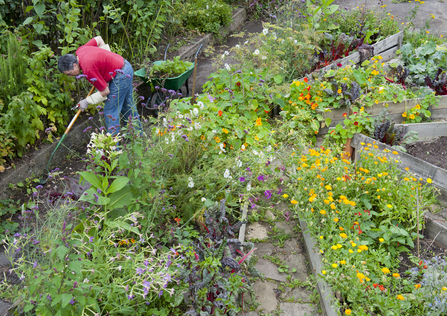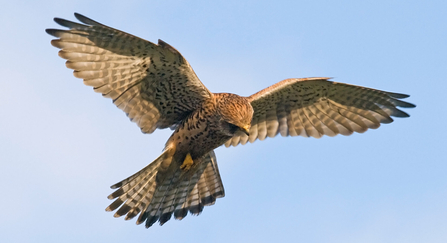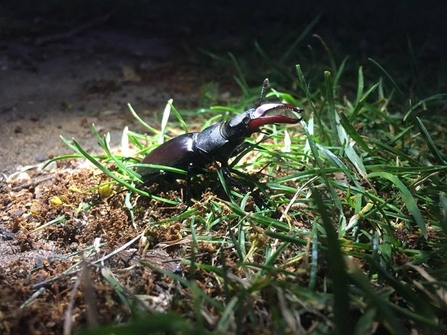By national standards, our Suffolk towns are relatively modest in size and typically reflect in their character the rural nature of the county. Most are blessed with numerous parks, allotments, street trees and often large remnants of semi-natural habitat that for one reason or another were unsuitable for development. Good-sized gardens were common in many post-war developments, but open spaces were rarely left, and transport infrastructure was designed around the car. Newer developments have typically crammed more houses into each development site, hence smaller gardens are now the norm. Larger developments have usually made some provision for open space in the form of mini-parks, greens and cycleways, so the combined area of garden and open space has not been reduced too much overall.
Wild about towns
Suffolk Wildlife Trust urban vision illustration, Dan Hilliard, 2021

Community gardening - Paul Harris/2020vision
However, infill development has resulted in the loss of many large and often mature gardens that offered wildlife a home. The trend for paving front gardens has further eroded ‘green cover’. The use of close-board fences to replace hedges and enclose new gardens has made it much more difficult for some species to move around, including hedgehogs, which have felt the impact on their ability to forage in gardens and frogs or toads, which might find the route back to their breeding pond blocked. ‘Hedgehog Highways’ are a simple remedy – small holes in the bottom of fences that allow small animals to move freely around rows of back gardens.

Hedgehogs - Jon Hawkins/Surrey Hills Photography
The late 1970s and 1980s saw rapid housing expansion, especially on the eastern fringe of Ipswich with big developments in Martlesham Heath and Warren Heath. The names say it all. These were some of the few remaining heaths that had escaped the plough only to disappear under hundreds of new homes. Heathlands no longer had agricultural value and their wildlife, cultural and landscape value was little understood, so these areas were labelled as perfect for development. There was a token attempt to relocate a part of Warren Heath where turves of heather were dug up and transported to a new location, but this was a pointless exercise as lowland heath is an entire ecosystem and you cannot simply relocate an ‘ecosystem’.
Meadow brown on bell heather
Habitats reimagined
Lowestoft must be one of the most habitat-diverse towns in England. Along the coastal fringe are sand dunes, vegetated shingle and soft cliffs capped by heathland, while on the western side are fens, reedbeds and broads. North Lowestoft has pockets of ancient woodland and orchid-rich grasslands while south of Lake Lothing are small wetlands and remnant areas of heath: a remarkable assemblage of habitats. There have been losses over the past 60 years though, and the development of a large supermarket on extensive green-winged orchid meadows was amongst the worst.
Gunton Warren - Steve Aylward
The future for our urban wildlife looks much more promising today with many great initiatives. The Ipswich Parks team have been amongst those leading the way with changes in management to benefit wildlife through the creation of meadow areas and wetlands, while Ipswich Golf Club has brilliantly integrated the natural heathland habitat into the courses at Purdis and Bixley. In Lowestoft and elsewhere, East Suffolk Council has stopped mowing grassland on wide road verges during the summer to create wonderful flower-lined routes through the town. This will benefit pollinating insects and could bring more kestrels into built-up areas again, demonstrating that even relatively small changes in the way we manage land can make a huge difference for wildlife.

Kestrel - Bob Coyle
Wild gardens
Town gardens are a potentially huge wildlife resource. With more and more people bringing wildlife into their gardens there is an exponential benefit as the number of wildlife-friendly gardens grows. Neighbouring garden-wildlife ponds effectively become a single entity sharing frogs, toads, dragonflies and other creatures. This enables populations of species to build and creates resilience by reducing dependency on a single pond or wildflower patch. Flying insects such as stag beetles, white-tailed bumblebees and speckled wood butterflies will quickly take advantage of deadwood piles, nectar-rich wildflowers and patches of unmown grass.
Speckled wood butterflies by Steve Aylward
There are several big new developments in the pipeline around Ipswich, Lowestoft and Bury St Edmunds with the Ipswich ‘Garden Suburb’ amongst the biggest. This is an opportunity for bold and ambitious town planning to drive the creation of large wildlife-rich green spaces on the doorstep of new homes, in turn enhancing the mental and physical health of generations of future residents. There is only one opportunity to get it right and it must be taken now.

Stag Beetle, Pipers Vale - Lucy Shepherd
The next 10 years are a wonderful chance to bring our towns to life by building on the progress of recent years. Less mowing, less pesticides, more thoughtful and sensitive management of open spaces and more urban tree planting could radically transform our towns. As electric cars become the norm, air quality will significantly improve benefitting both ourselves and the wildlife we share our towns with. Lots of people dream of escaping to the country, but why when our towns could be every bit as wildlife rich as the countryside?
